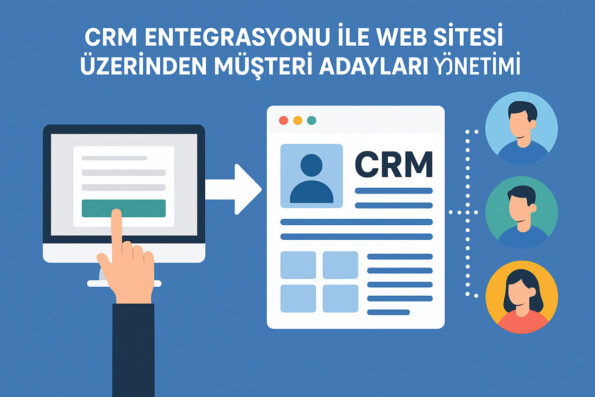Your visitor came to your website. He read a blog post. He was interested in one of your services. He filled out the form and asked for “more information.”
So what happened next?
If this form fell into an e-mail box and was forgotten there; if it was not recorded by any system; or even if it was not clear who would be interested…
That lead was not yours, but your competitor’s.
Today, a website should not just promote.
It should collect demand. It should process demand. A relationship should arise from the demand, and a sale should arise from that relationship.
The center of this chain is CRM integration.

The Digital Installation and Corporate Web Management Model developed by Adapte Dijital integrates the CRM system into the website, establishing a system where customer leads not only “come” but also are monitored, scored and managed. In this article, we will explain in detail what CRM integration is, why it is necessary, how it works and how to implement it.
İçindekiler
Toggle1. What is CRM? What Does It Have to Do with a Website?
CRM (Customer Relationship Management), or Customer Relationship Management, is not just post-sale customer tracking.
In fact, CRM is a communication and management system that includes potential customers.
Website + CRM = Digital Sales Process
Every request that comes to your website is actually a sales opportunity.
This opportunity should be systematically recorded, monitored, should be processed and directed.
CRM integration manages this process.
Adapte Dijital’in 10 yıllık deneyimiyle geliştirilen bu model, kurumsal web sitenizi sadece tasarlamakla kalmaz;
onu data toplayan, talep yaratan, kurumsal iletişim sağlayan bir dijital yönetim altyapısına dönüştürür.
Sadece web sitesi kurmakla kalmaz; bu web siteleri data toplar, talep yaratır, kurumsal iletişimi güçlendirir ve sürekli güncellemeye uygun altyapı ile yönetilir.
Why is Email Tracking Insufficient?
Because:
- Emails can be forgotten
- Cannot be tracked
- Unclear who will handle it
- Requests can be mixed
- Cannot be reported
All these problems are eliminated with CRM.
What Does CRM Integration Provide?
- Data from the form is automatically recorded
- Visitor’s sector, interest, page they came from are known
- Task assignment is made (who will take care of it?)
- Request statuses are monitored (new, under discussion, offer made, closed etc.)
- Sales performance is measured
- Demand sources are compared (organic traffic or advertising?)
Digital Installation and Corporate Web Management Model: Turn Your Digital Installation into Strategy, Your Website into Profit!
2. How to Set Up a CRM Integration Process?
A successful CRM integration is not just a technical connection.
It is a strategic planning process.
It should be defined how your website will talk to your CRM, what information it will transfer and to whom it will be transferred.
Steps to be Taken for CRM Integration
- Determining goals (what kind of data will be collected?)
- Planning web form fields
- Designing the CRM structure specifically for your sector
- Writing automation scenarios
- Assigning tasks and departments
- Ensuring data security and KVKK compliance
Which CRMs can be used?
Some of the systems we use and integrate as Adapte Dijital:
- HubSpot
- Zoho CRM
- Pipedrive
- Freshsales
- Salesforce
- Logo CRM (Turkey focused)
- custom developed customer tracking systems
- Each form must be directed to a separate flow
- The page information the visitor came from must be recorded in the CRM
- Time stamp must be taken
- Requests should be assigned automatically
- First response time should be measured
- Suggests a suitable solution
- Closes the sales process
Things to Consider in CRM Integration
3. Benefits of Managing Incoming Requests with a CRM
Forms that come to your website are not just a communication, they are a statement of intent.
I am interested. I am asking. I am curious. I can buy.
CRM transforms this intent into a trackable process.
Gives Clarity to Business Processes
Steps such as who looked at which request, on what date did they respond, when was the offer presented become trackable by the system.
Now, “who responded to that request?” Questions like these will become history.
Makes Following Up Easier
Each request becomes a record in the CRM.
It can be reached tomorrow, a week later, even a month later.
If necessary, contact is made again, interest is renewed.
Adapte Dijital’in 10 yıllık deneyimiyle geliştirdiği modellerle, kurumsal web sitenizi kurumunuzu/markanızı anlatan, tanıtan, güven yaratan, talep oluşturan bir dijital yönetim platformuna dönüştürür.
Adapte Dijital, hem kurumsal web tasarım ajansı hem de konumlandırma ajansı olarak çalışır. Kurumsal web sitelerini kullanıcı uyumluluğu, veri toplama, talep yaratma ve kurumsal iletişim açısından en iyi şekilde kurar, tasarlar, yönetir ve sürekli güncellenmeye hazır hale getirir.
Provides Focus to Sales Teams
Who should the sales team spend their time with?
Scored, segmented data in CRM provides the answer to this question.
The hottest, most urgent, and highest potential demands are prioritized.
Provides Performance Evaluation
Which sales representative meets more demands?
How many demands turn into sales?
How many remain unanswered?
All of these can be reported via CRM.
Digital Installation and Corporate Web Management Model: Turn Your Digital Installation into Strategy, Turn Your Website into Profit!
Process Monitoring and Reporting
- Each step can be monitored
- Failure points is detected
- Conversion rates are calculated
If this structure is not established, sales will depend on personal memory, file archives or luck.
5. Demand Scoring and Segmentation: Right Time, Right Person
Not every demand has the same value.
Someone is targeting 1 month from now, someone is comparing prices, and someone is ready to buy tomorrow.
With CRM integration, you understand these differences and have the chance to reach the right person at the right time.
How Does the Scoring System Work?
Certain criteria for scoring demands used:
- Selections in the form (urgency, budget, product interest)
- Behavior on the website (how many pages have been visited?)
- Industry and position information
- Previous contact history
Advantages of Segmentation
- Presentation is sent to those who want training
- Those who want a quote are directed to direct sales
- Partnership request is forwarded to the relevant unit
- A different campaign is offered to those who are interested in dealership
Communicating According to Target
Instead of “Dear Visitor”, saying “We have a special solution for X sector” increases conversions many times over.
This is possible with CRM.
Digital Installation and Corporate Web Management Model: Turn Your Digital Installation into Strategy, Turn Your Website into Profit!

6. The Role of CRM Integration in the Digital Installation Model
CRM integration is planned at the earliest stage in the digital systems we establish as Adapted Digital.
Because every data we collect must remain in the system, be processed and transformed.
CRM Planning in Website Installation
- Each form field is designed as a data point
- A separate CRM flow is determined for each form
- Which information will fall into which category is defined
- Return time, assignment, priority level are systematized
Automation and Time Saving
- Automatic email to the visitor
- Task notification to relevant staff
- Reminders after a certain day
These are not manual, they work with the system.
Monthly CRM Reports and Development
Every month:
- How many forms did you receive?
- How many leads did you convert into sales?
- Which channel generated more leads?
- What is the average first turnaround time?
With this data, managers guide their sales team, content strategy is determined, a campaign plan is made.
Digital Installation and Corporate Web Management Model: Turn Your Digital Installation into Strategy, Your Website into Profit!
7. Conclusion: Lead Data is the Future of Sales
Today’s most valuable resource is neither commodity, nor money, nor stock.
It is data.
Data tells you what to offer, when, with whom, and at what price.
CRM integration is not just a software job.
It is the decision to take the lead seriously, save it in corporate memory, and manage it professionally.
Website + CRM + content strategy = digital sales infrastructure.
With our digital installation model that enables businesses to switch to this structure as Adapte Digital,






